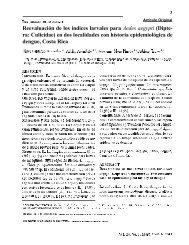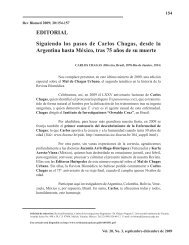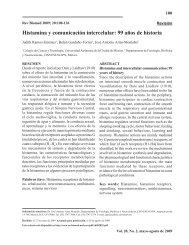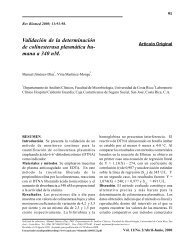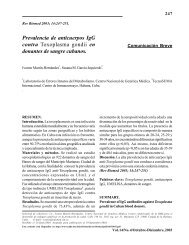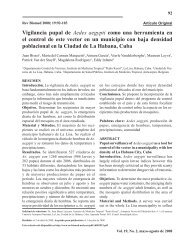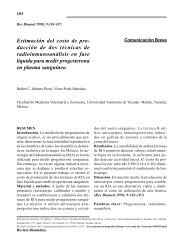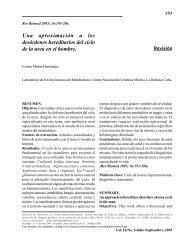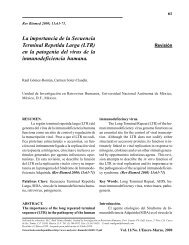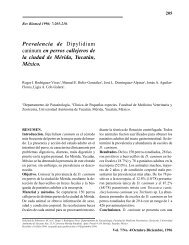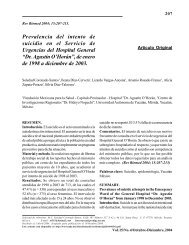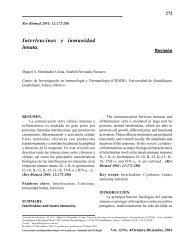Biochemical serum markers for Down syndrome screening. - Revista ...
Biochemical serum markers for Down syndrome screening. - Revista ...
Biochemical serum markers for Down syndrome screening. - Revista ...
Create successful ePaper yourself
Turn your PDF publications into a flip-book with our unique Google optimized e-Paper software.
264<br />
IB Baluja-Conde, MR Rodríguez-López, O Zulueta-Rodríguez, B Ruiz-Escandón, et al.<br />
be<strong>for</strong>e implantation in the uterus. hCG enters the<br />
maternal circulation almost immediately after<br />
implantation of the embryo (blastocyst) on about<br />
day 21 of the menstrual cycle (10, 11, 13).<br />
High maternal <strong>serum</strong> levels of hCG with low<br />
levels of MSAFP have been associated with an<br />
increased risk of carrying a <strong>Down</strong> <strong>syndrome</strong> fetus.<br />
Studies have reported elevated second trimester<br />
hCG levels varying from 2.04 to 2.5 MoM or<br />
greater. A geometric mean MoM <strong>for</strong> <strong>Down</strong><br />
<strong>syndrome</strong> pregnancies determined from the results<br />
of 18 studies, comprising a total of 559 DS cases,<br />
was 2.03 (10). Other investigators examined hCG<br />
levels in 77 <strong>Down</strong> <strong>syndrome</strong> pregnancies and, using<br />
maternal age and hCG levels, estimated a 60%<br />
detection rate at a false positive rate of 6.7%<br />
(16,17,27,28,36). At a cut-off risk of 1/380 Kevin<br />
Spencer et al. found a 57.9% detection rate at a<br />
false positive rate of 8.5% (42).<br />
Other studies showed that the usefulness of free<br />
b-hCG is superior to that of total hCG in maternal<br />
<strong>serum</strong> <strong>screening</strong> (43, 44). In 2000 Hallahan et al.<br />
analysed 63 cases of DS and 400 unaffected control<br />
pregnancies between 10 and 13 weeks of gestation<br />
to compare free b-hCG versus intact hCG in first<br />
trimester <strong>Down</strong> <strong>syndrome</strong> <strong>screening</strong>. Free b-hCG<br />
combined with maternal age detected 45% of <strong>Down</strong><br />
<strong>syndrome</strong> pregnancies at a 5% false positive rate.<br />
Intact hCG combined with maternal age<br />
demonstrated detection efficiency comparable to<br />
maternal age alone (35% versus 32%) (45). This<br />
study demonstrated that free b-hCG was actually<br />
a better marker than intact hCG.<br />
Free b-hCG.<br />
The free b-subunit of hCG is present in <strong>serum</strong><br />
throughout pregnancy. Reports of amounts of free<br />
b-subunit in second trimester <strong>serum</strong>, however, vary<br />
widely. Free b-hCG subunit concentrations average<br />
0.5% to 4% of total hCG levels (46, 47, 48). The<br />
possible causes of variations in free b-subunit values<br />
include hCG dissociation and effects of nicks in free<br />
b-hCG on immunoreactivity.<br />
In 1995, Eldar-Geva et al. showed that,<br />
although the production of each subunit’s hCG<br />
<strong>Revista</strong> Biomédica<br />
messenger RNA is increased in <strong>Down</strong> <strong>syndrome</strong><br />
pregnancies, b-subunit production is more<br />
markedly increased (49). This finding suggests that<br />
the free b-hCG subunit might be superior to intact<br />
hCG <strong>for</strong> <strong>Down</strong> <strong>syndrome</strong> detection. Various<br />
authors have reported that the effectiveness of free<br />
b-hCG methodologies is superior to that of total<br />
hCG in maternal <strong>serum</strong> <strong>screening</strong> (43-45).<br />
Ultrasound is a powerful diagnostic tool, but<br />
its accuracy lies in the skill and experience of the<br />
practitioner, and there<strong>for</strong>e the accuracy of<br />
ultrasound analysis can vary. Some studies suggest<br />
that the risk <strong>for</strong> <strong>Down</strong> <strong>syndrome</strong> may be reduced<br />
when an ultrasound is deemed normal after<br />
knowledgeable interpretation by an experienced<br />
practitioner. Due to the inconsistencies that currently<br />
exist in the training and interpretation of ultrasound,<br />
the American College of Obstetricians and<br />
Gynecologists recommends that ultrasound<br />
<strong>screening</strong> <strong>for</strong> <strong>Down</strong> <strong>syndrome</strong> be limited to<br />
specialized centers (23, 24, 50).<br />
An ultrasound finding that shows an increase<br />
in the size of the normal, clear area behind the baby's<br />
neck (nuchal translucency) early in pregnancy is<br />
associated with an increased incidence of <strong>Down</strong><br />
<strong>syndrome</strong>. Researchers believe that nuchal<br />
translucency may reflect accumulation of lymph fluid<br />
(25, 26).<br />
In 2000, Spencer et al. showed that the<br />
detection of affected pregnancies can be improved<br />
to over 80% with ultrasound measurement of fetal<br />
nuchal thickness or translucency, with or without<br />
measurements of free b-hCG, and a new marker,<br />
pregnancy-associated plasma protein-A (PAPP-<br />
A), in the mother’s blood during the first trimester<br />
(51). Studies have reported elevated first trimester<br />
b-hCG levels from 2.45 MoM or greater(34).<br />
Studies indicate a wide variation (30% to 86%)<br />
in the accuracy of nuchal translucency as a predictor<br />
of DS. This range may result from differences in<br />
expertise and techniques <strong>for</strong> measuring nuchal<br />
translucency. In addition, there is no consensus on<br />
the definition of what measurement constitutes an<br />
increased nuchal translucency (25, 26, 52, 53).



